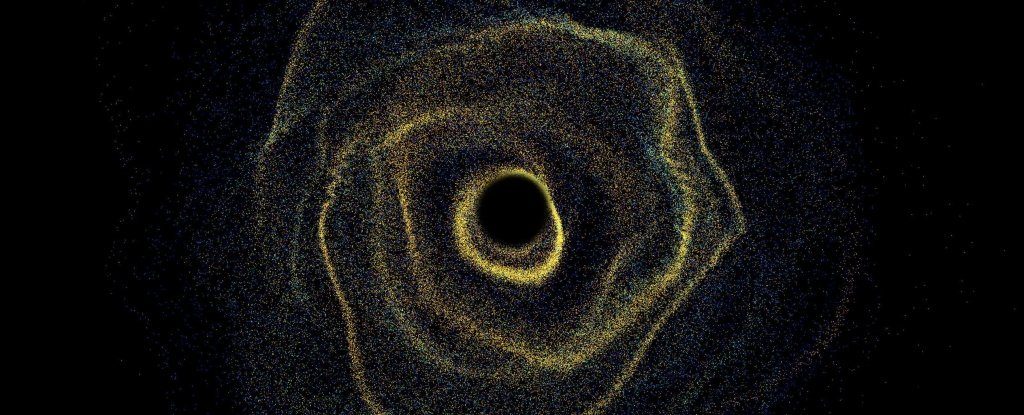Researchers tracking the gasses in the middle of the Milky Way have concluded the clouds are orbiting an object 10,000 times the mass of the Sun - and yet, when they look at where that object should be, nothing is there.
The most obvious explanation is a quiescent black hole, one that isn't actively feeding, and therefore is emitting no detectable radiation.
It is, the researchers say, the fifth such candidate in the galactic centre, mounting evidence that not only do intermediate mass black holes exist, but that they're abundant in the heart of the Milky Way.
Intermediate mass black holes are exactly what they sound like. We know stellar mass black holes, up to 100 times the mass of the Sun, exist. The biggest black hole we've detected in this mass range is 62 solar masses, created by the merger of two black holes in the gravitational wave event GW150914.
We also know supermassive black holes exist, like those that power galaxies. They start at around 100,000 solar masses, but they can get almost incomprehensibly massive, by means we have yet to discover.
The class that sits in between them - between 1,000 and 100,000 solar masses - is called intermediate mass black holes. They have remained extraordinarily elusive. This raises questions such as "do they exist?" and "if they don't exist, why?" and "if they do exist, why can't we find them?"
Because black holes don't emit any detectable radiation of their own, scientists have to get creative in their search. Instead of looking for the black holes, they look for the effects black holes would have on other objects in nearby space.
Astrophysicist Shunya Takekawa of the National Astronomical Observatory of Japan and colleagues have been studying the motion of the high-velocity clouds of gas in the centre of the Milky Way to help answer these questions.
Their paper has been accepted by The Astrophysical Journal, and is available on the pre-print server arXiv.
Previously, they used the gas-tracking method to identify an intermediate mass black hole candidate clocking in at around 32,000 solar masses, which would produce an event horizon - the spherical region of space around a black hole past which light cannot escape - roughly the size of Jupiter.
Now, they've applied it to a high-velocity gas cloud called HCN-0.085-0.094. It mainly consists of three smaller clumps; one of those clumps seems to be swirling around - but not being accreted by - a black hole.
"One of the three clumps has a ring-like structure with a very steep velocity gradient," the researchers wrote in their paper.
"This kinematical structure suggests an orbit around a point-like object with a mass of ∼104 solar masses. The absence of stellar counterparts indicates that the point-like object may be a quiescent black hole."
For a handy comparison, at that mass range, the black hole's event horizon would be a little bigger than Uranus or Neptune.
Oddly behaving clumps of gas and dust aren't the only way to find intermediate mass black holes.
Amongst other candidate observations is a star caught moving at incredible speed from the centre of the Milky Way, on a trajectory into intergalactic space. Analysis has shown that an intermediate mass black hole is the most likely thing to have given that star the punt it needed to achieve such velocity.
There was also a tremendous flare of multi-wavelength radiation that started in 2003, and gradually died down over the course of a decade. The distribution of the photons suggested that it was an intermediate mass black hole, a few tens of thousands of solar masses.
Newly released analysis of follow-up observations supports this, making it one of the best candidates yet, but it's 740 million light-years away. The galactic centre is a lot closer, which means if we find any intermediate mass black holes there, they may be easier to study.
That could help us figure out such questions as - how do they form? And how do supermassive black holes form? A census could help us to understand how common or rare intermediate mass black holes are, and how they are distributed across galaxies.
So far, the results of the research indicate that looking at swirling gas at the heart of the Milky Way is a reliable method to search for intermediate mass black hole candidates; but we are yet to confirm one of them for sure. Watch this space.
The research has been accepted by The Astrophysical Journal, and is available on arXiv.




And how can a black hole look like its quiescent? Anyone can explain it in layman terms? lolz